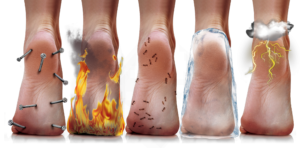- A new survey conducted by Viatris, reveals the impact of neuropathic pain on diabetes sufferers and the importance of early diagnosis
- 1 in 4 diabetic patients will develop painful diabetic peripheral neuropathy (pDPN)
- The majority of patients with pDPN are not diagnosed for up to 6 months

Petaling Jaya, 26 September 2023 – September is global Pain Awareness Month, a time to raise public awareness and understanding on pain and pain management. Pain conditions affect a great number of people with 30% of the world’s population affected by chronic pain, meaning they have been living with persistent or recurrent pain for periods longer than three months.
To learn more about the impact of neuropathic pain (NeP) and unmet needs of diabetes sufferers, Viatris conducted a new survey, involving 963 patients from Italy, Spain, Malaysia, Mexico, and South Korea.
Neuropathic pain (NeP) is defined as pain caused by a lesion or disease of the somatosensory nervous system. While this condition accounts for 20-25% of chronic pain, it is still commonly underdiagnosed with patients not receiving appropriate treatment. One of the most common causes of NeP is diabetic peripheral neuropathy (DPN), which is the most prevalent chronic complication of diabetes since it causes nerve damage leading to severe pain in the feet, legs, and hands.
1 in 4 people with diabetes can develop painful diabetic peripheral neuropathy (pDPN). This affects people’s ability to perform daily activities and greatly impacts their quality of life from both an emotional and practical perspective. People living with diabetes and NeP describe pain in their feet or lower limbs as ‘hot burning flames from a fire’, prickling ‘thin pins and needles’, ‘electric shocks from a violent lightning bolt’, sharp pains from a ‘stabbing knife’, hundreds of ants ‘crawling in an annoying and nagging way’ and they experience worry, anxiety, and fright.
Today, nearly half a billion people have diabetes worldwide and, as cases are expected to increase by 51% by 2024, the associated complication of NeP is equally becoming a growing concern.

Patients’ awareness and hope about their symptoms
According to the survey, 68% patients in Malaysia claimed to be aware of the association between pain symptoms and diabetes before their diagnosis. Nevertheless, from the initial onset of symptoms, the main thoughts that crossed patients’ minds were a connection to other existing conditions (25%); a hope that they would go away (39%); a connection to ageing (40%); a temporary condition (36%).
Diagnosis experience
On average, the majority of respondents globally contacted a physician within 4 months from the first signs and symptoms and received their diagnosis within 6 months from the onset of their symptoms. In Malaysia, the prevalent HCP responsible for the diagnosis was endocrinologist, for 68% of respondents, but also general practitioner and pain specialist played an important role for 7% and 5% of respondents, respectively. However, misdiagnosis is still an issue with 63% of respondents in Malaysia claiming to have received an incorrect diagnosis before the final one.
Painful diabetic peripheral neuropathy (pDPN) affects patients’ mood and ability to perform daily activities
Living with pDPN greatly impacts different aspects of a person’s life, both emotionally and practically, as confirmed by nearly half of the patients interviewed who claimed that their quality of life is very much or completely affected by the condition. Indeed, 75% of patients in Malaysia stated that they had to adjust their work schedules while 61% even took a long absence from work.
37% of respondents in Malaysia claimed that pDPN has had an impact on their overall mood; their ability to play sports (48%) and the quality of their sleep (37%). However, despite its significant impacts, only 1 in 5 patients globally feel they can talk freely about their condition. In Malaysia, the main reasons for not sharing in 51% patients are the fear of being discriminated against followed by fear of having problems at work and shame or embarrassment in 46% and 38%, respectively.
As pDPN progresses, early diagnosis and treatment are crucial
Receiving appropriate and timely treatment for NeP is vital to help keep the underlying disease under control and improve quality of life. Overall, 58% of the patients in Malaysia surveyed are taking prescription drugs, of which, 23% claim to be very much or completely satisfied with their treatment, respectively. In Malaysia, other treatments being taken are dietary supplements, for 55% of respondents, but also physiotherapy for 48% and herbal remedies for 33%. Generally, 48% of the patients feel supported by their loved ones and 51% have learned to live with their condition.
Despite the fact that patients claimed to be satisfied with the explanation they received about chronic pain associated with diabetes as well as the explanation about their treatment options and related outcomes, 44% of patients in Malaysia still fear they won’t be able to fully recover from the condition and 42% feel as though they are no longer the same person as they were before. While most symptoms tend to recede over time, just under half of the patients surveyed (44%) claimed they currently experience intense pain.
“At Viatris we are committed to supporting people living with painful diabetic peripheral neuropathy as the associated chronic pain significantly impacts patients’ quality of life. This is why we continue our efforts to raise awareness on the importance of early detection and access to the correct treatment as well as listen to the unmet needs and challenges that people with this condition still face today,” said Jeff Bote, Country Manager of Viatris Malaysia.
With the benefit of hindsight, 1 in 3 patients globally would have asked for advice about their symptoms sooner, not have underestimated them and explained them better to their physician. In general, in terms of the kind of support patients feel they need to have, 36% in Malaysia claimed they would like to receive more information on the daily management of chronic pain associated with diabetes followed by 43% needs a greater awareness among the general public on the burden of chronic pain associated with diabetes and 47% who needs access to psychological support.